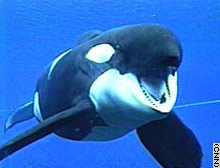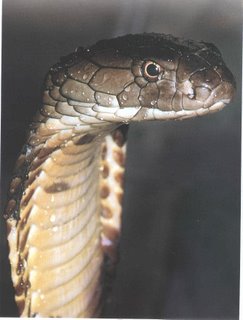
Oops! Wrong title! The orca is neither a killer nor a whale!
18th-century Spanish sailors referred to the orca as ‘whale killer’ (because of their habit of attacking whales), which was incorrectly translated into English as ‘killer whale.’ But like the whale, it also is an aquatic mammal - the largest member of the dolphin family.
Because their behavior is similar to that of wolves, some also call them “sea wolves”. And for those of us who have never seen a live orca, there is the memory of Keiko who starred in all the three Free Willy movies.
The orca has a rubbery but sensitive black skin with a white underbelly, white patches over the eyes and saddle patch markings near the dorsal fin, which provide good camouflage in the flickering, underwater light.
With a weight of up to 10 tons and equipped with sharp, flesh-tearing teeth, the cetacean gathers tremendous momentum as it bears down on prey at speeds of about 55 km/hour.
Orcas hunt sea lions or penguins solo but herd fish together in groups called ‘pods’ and then attack them from different angles.
A pod is not just a group of orcas formed spontaneously but an extended family. Groups of pods sharing the same tradition of sounds by which they communicate (called ‘whale song’) are known as ‘clans’.
Two or more pods come together to form a temporary ‘superpod’ for breeding purposes. After a gestation period of one year and a half, a single calf is born which suckles for about 18 months, staying close to its mother’s side and later retaining a lifelong bond.
There are three types of orca: ‘Resident’ orcas stay within a home range and eat mainly fish; ‘transient’ orcas, as the name suggests, are nomadic in nature, living in the same areas as resident orcas but generally ignoring each other and feeding on whales, fish and marine mammals; ‘offshore’ orcas cruise the open oceans in groups of up to 60, feeding on fish, sharks and turtles.
Orcas socialize by rubbing their bodies together, slapping their tail and pectoral fins against the surface and lifting their heads out of the water, a process called ‘spy-hopping’. This makes them candidates for amusement parks, which hold them in captivity. Fortunately, this fell out of favour with the general public due to the huge success of Free Willy, which inspired a campaign for the release of Keiko.
Keiko was airlifted from the USA to Iceland in July 2002 where he was released into the open sea, but he swam 1400 kms straight to Norway and stayed in a bay there, keeping constant contact with humans till his death in December 2003.
Copyright © 2006 Noël Gama
Friday, November 24, 2006
Orca:The Killer Whale
Saturday, November 11, 2006
King Cobra: The Original Face-Off Hood!

The Hooded One has been doing it much before the hood in the Hollywood blockbuster, Face-Off.
Not only that! He has also been doing a far better job than the world’s top surgeons are currently trying to do: the King Cobra peels the skin off his head even uncovering new fangs, teeth and tongue!
What makes him king? He is the longest venomous snake in the world with enough venom to kill 20 soldiers or an elephant, with a single bite.
Unlike other cobras, the King Cobra hunts by day. It detects prey by sight and scent, flicking its tongue in and out. As the tongue slips back into its mouth, it passes over the Jacobson organ which analyzes smell.
On spotting its prey, it makes a lightening-fast lunge and bites it, injecting venom through its two hollow half-inch long fangs. The fast-acting toxin affects the victim’s nervous system, paralyzing respiratory muscles, resulting in death.
It then swallows its prey, dislocating its jaw to help swallow large ones.
When startled or threatened, it takes its classic upright position with about one third of its upper body off the ground, hood flared open.
But the King prefers to flee rather than attack, except when cornered or when one accidentally steps on it or its nest.
During the breeding season, it may seem to the uninitiated that two cobras with necks entwined are mating, when in fact they are just two males wrestling over a female. The winner then rubs his chin along his queen’s body calming her and preparing her for mating. The rest of it is too serpentine a tale to go into!
The queen builds a nest by pushing leaves, grass, sticks and soil together to form a pile into which she makes a hollow and lays her eggs, covering them again and then lying over them.
The king guards the eggs along with his queen during the incubation period of two to three months.
The King Cobra sheds its skin four to six times a year during a two-week shedding cycle.
Laughter will be the thing furthest from your mind should you ever encounter this king-in-invisible-clothes.
Copyright © 2006 Noël Gama
Thursday, November 02, 2006
Peacock: National Bird of India

Here’s one beauty that wins ‘tails up’ against any beauty queen in categories like costume, dancing, posing and strutting among others - in spite of being male!
With a fan-shaped crest on its head for a crown and a long train of ornamental feathers on its iridescent blue and green body, the Indian peacock is one of the world’s most spectacular birds.
The train of the peacock, is not a true tail but frond-like plumes called ‘coverts’ that cover the short tail feathers underneath. An adult peacock has about 150 coverts, each measuring about five feet. The train feathers have a series of eyespots that are best seen when the train is erect and fanned out.
Peafowl are sociable and live in a group called ‘ostentation’ or ‘muster’ comprising one male and about five females.
The peacock screeches, struts about, spreads out and vibrates his magnificent tail, angling it over his head like a fan to attract the peahen (who has a crest but does not have a train). The more eyespots on the peacock’s train, the more attractive he is to potential mates!
After mating, the feckless peacock’s role is over, and he plays no part in nest-building or raising the young.
In the wild, the peafowl spend much of their time on the ground looking for food. They tend to forage in the same place every day, scratching over earth and leaf litter to uncover worms and seeds.
Peafowl warn each other of danger by emitting loud, shrieking cries and honks. They have pointed spurs on the backs of their legs for kicking in defense.
When flushed, they take flight with little noise, rising almost vertically to the tree tops although they do not fly far.
They roost in tall trees at night, to keep safe from predators like dogs, foxes, leopards and tigers.
Nothing symbolizes India as accurately and completely as the peacock: the multifaceted cultures in its iridescent blue-green plumage, unity in diversity in the harmony of its clashing colours, the Bharat Natyam in its dancing poses, the classic namaste poise of its head… Go on, look around you at the Diwali lamps, at the fireworks… and add to the list!
No wonder, this non-migratory Indian beauty is found in zoos, parks and gardens all over the world - the de facto goodwill ambassador of India.
Copyright © 2006 Noël Gama



